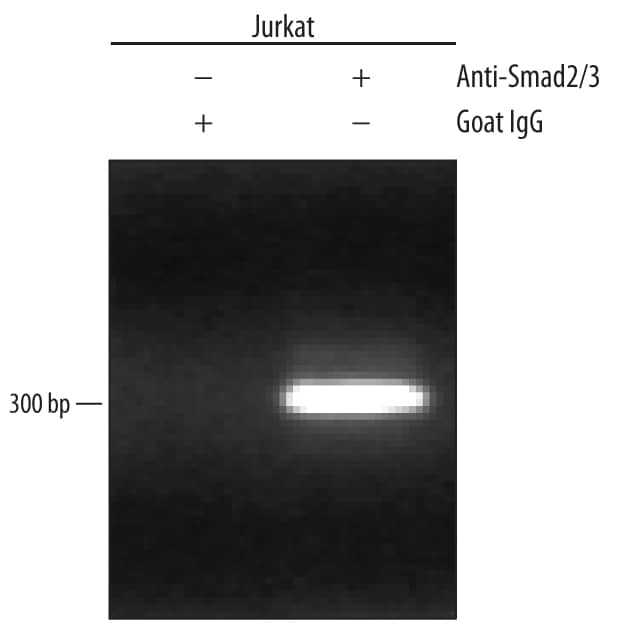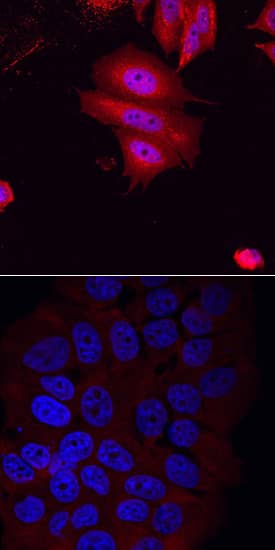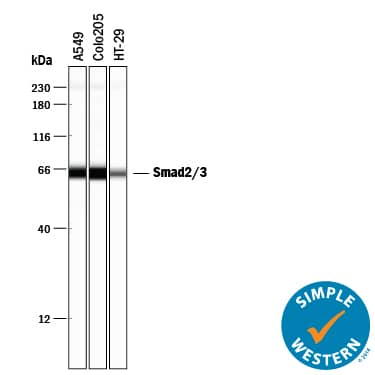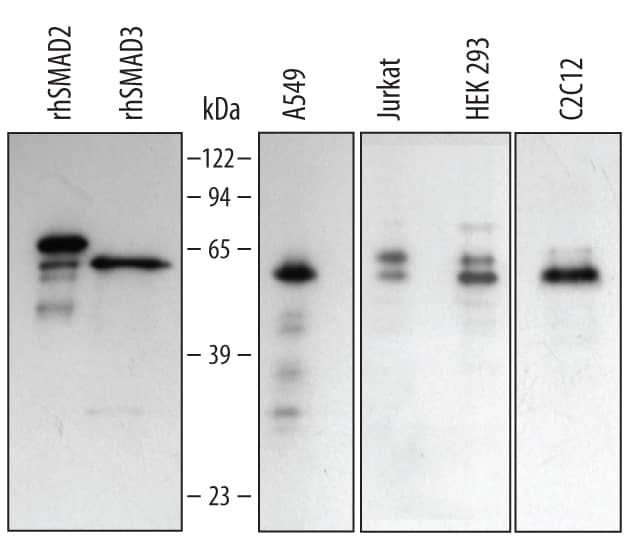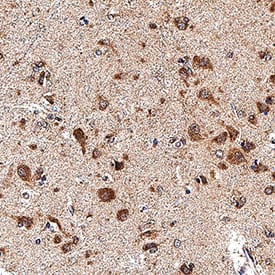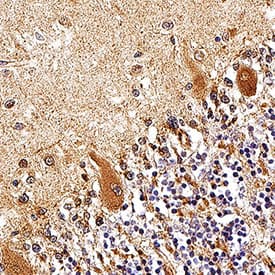Human/Mouse Smad2/3 Antibody
R&D Systems, part of Bio-Techne | Catalog # AF3797

Key Product Details
Validated by
Species Reactivity
Validated:
Cited:
Applications
Validated:
Cited:
Label
Antibody Source
Product Specifications
Immunogen
Ser2-Ala230
Accession # P84022
Specificity
Clonality
Host
Isotype
Scientific Data Images for Human/Mouse Smad2/3 Antibody
Detection of Human/Mouse Smad2/3 by Western Blot.
Western blot shows lysates of A549 human lung carcinoma cell line, Jurkat human acute T cell leukemia cell line, HEK293 human embryonic kidney cell line, and C2C12 mouse myoblast cell line. PVDF membrane was probed with 0.5 µg/mL Goat Anti-Human/Mouse Smad2/3 Antigen Affinity-purified Polyclonal Antibody (Catalog # AF3797) followed by HRP-conjugated Anti-Goat IgG Secondary Antibody (Catalog # HAF109). For additional reference, recombinant human Smad2 and Smad3 were included. Specific bands for Smad2 were detected at approximately 64 and 58 kDa (as indicated). This experiment was conducted under reducing conditions and using Immunoblot Buffer Group 2.Detection of Smad2/3-regulated Genes by Chromatin Immunoprecipitation.
Jurkat human acute T cell leukemia cell line treated with 50 ng/mL PMA and 200 ng/mL calcium ionomycin for 30 minutes was fixed using formaldehyde, resuspended in lysis buffer, and sonicated to shear chromatin. Smad2/3/DNA complexes were immunoprecipitated using 5 µg Goat Anti-Human/Mouse Smad2/3 Antigen Affinity-purified Polyclonal Antibody (Catalog # AF3797) or control antibody (Catalog # AB-108-C) for 15 minutes in an ultrasonic bath, followed by Biotinylated Anti-Goat IgG Secondary Antibody (Catalog # BAF109). Immunocomplexes were captured using 50 µL of MagCellect Streptavidin Ferrofluid (Catalog # MAG999) and DNA was purified using chelating resin solution. Thec-mycpromoter was detected by standard PCR.Smad2/3 in MCF‑7 Human Cell Line.
Smad2/3 was detected in immersion fixed MCF-7 human breast cancer cell line induced (upper panel) or non-induced (lower panel) to undergo epithelial-mesenchymal transition (EMT) using Goat Anti-Human/Mouse Smad2/3 Antigen Affinity-purified Polyclonal Antibody (Catalog # AF3797) at 10 µg/mL for 3 hours at room temperature. Cells were stained using the NorthernLights™ 557-conjugated Anti-Goat IgG Secondary Antibody (red; Catalog # NL001) and counterstained with DAPI (blue). Specific staining was localized to cytoplasm and, in EMT-induced cells, nuclei. View our protocol for Fluorescent ICC Staining of Cells on Coverslips.Applications for Human/Mouse Smad2/3 Antibody
Chromatin Immunoprecipitation (ChIP)
Sample: PMA and calcium ionomycin treated Jurkat human acute T cell leukemia cell line chromatin, c-myc promoter detected by standard PCR
Immunocytochemistry
Sample: Immersion fixed MCF‑7 human breast cancer cell line non-induced or induced to undergo epithelial-mesenchymal transition
Immunohistochemistry
Sample: Immersion fixed paraffin-embedded sections of human brain (cortex and cerebellum)
Simple Western
Sample: A549 human lung carcinoma cell line, COLO 205 human colorectal adenocarcinoma cell line, and HT‑29 human colon adenocarcinoma cell line
Western Blot
Sample: A549 human lung carcinoma cell line, Jurkat human acute T cell leukemia cell line, HEK293 human embryonic kidney cell line, and C2C12 mouse myoblast cell line
Reviewed Applications
Read 4 reviews rated 4.8 using AF3797 in the following applications:
Formulation, Preparation, and Storage
Purification
Reconstitution
Formulation
Shipping
Stability & Storage
- 12 months from date of receipt, -20 to -70 °C as supplied.
- 1 month, 2 to 8 °C under sterile conditions after reconstitution.
- 6 months, -20 to -70 °C under sterile conditions after reconstitution.
Background: Smad2/3
Smads are a family of intracellular proteins that transmit transforming growth factor beta (TGF-beta) superfamily signals from the cell surface to the nucleus. The Smad family is divided into three subclasses: receptor regulated Smads, (Smads 1, 2, 3, 5 and 8); the common partner, (Smad4); and the inhibitory Smads, (Smads 6 and 7). The binding of TGF-beta or activin to their cognate receptor induces phosphorylation of Smads 2 and 3. The activated Smads associate with the common-mediator subunit, Smad4, and the heteromeric complex translocates into the nucleus to initiate transcription. Smad3, also known as Mothers Against Decapentaplegic homolog 3 (MADH3), shares 83% amino acid identity with Smad2, also known as Mothers Against Decapentaplegic homolog 2 (MADH2). Human Smad2 has 99% identity to mouse and rat Smad2. Human Smad3 has 99% identity to mouse and rat Smad3.
Long Name
Alternate Names
UniProt
Additional Smad2/3 Products
Product Documents for Human/Mouse Smad2/3 Antibody
Product Specific Notices for Human/Mouse Smad2/3 Antibody
For research use only
